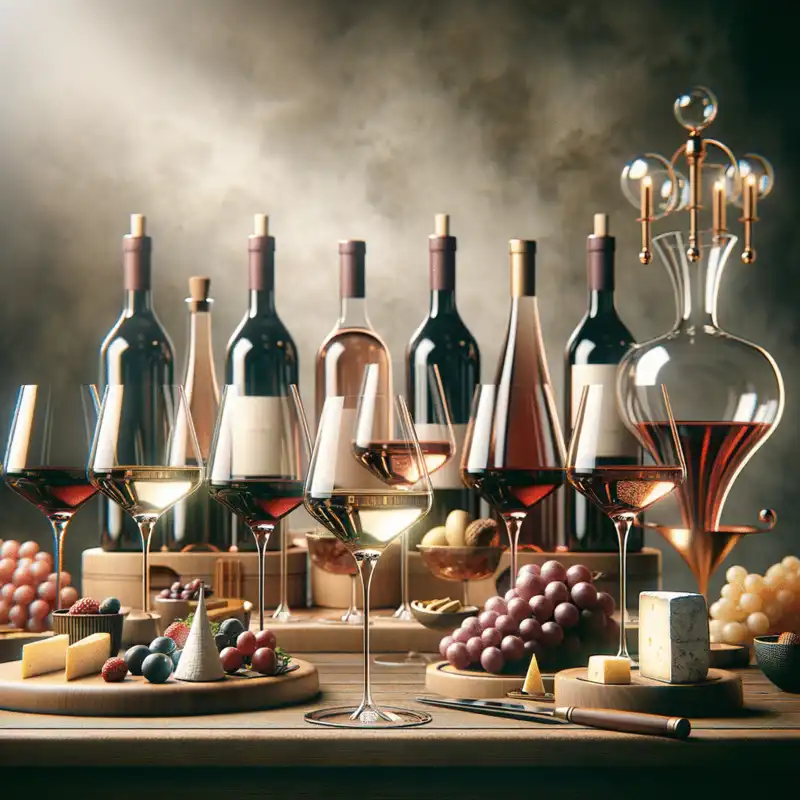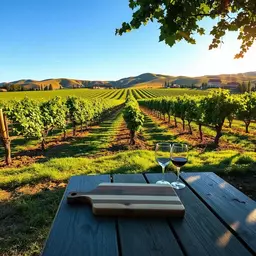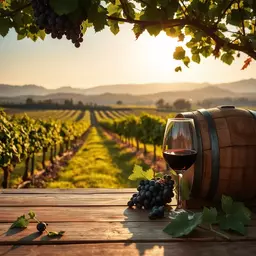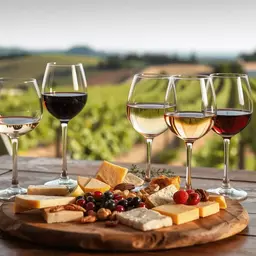Selecting Wine for Tasting Events

What if the secret to an unforgettable evening was simply a selection of the right wines? The choice of wine at your next tasting event can ignite conversations, create memories, and elevate the experience for everyone involved. Understanding how to curate this selection is key to connecting your guests with the magic of wine.
What You Will Learn
- Choosing wines that align with guest preferences enhances enjoyment and connection.
- Matching wines to the event theme creates a cohesive and memorable atmosphere.
- Well-paired wines elevate the flavors of food, enhancing the overall tasting experience.
- Using tasting notes and aroma wheels can transform the tasting into an interactive learning opportunity.
- Sharing the story behind each wine fosters deeper connections and engagement among guests.
- Encouraging guest interaction through icebreakers and discussions can lead to memorable moments.
- Teaching wine pairing and serving etiquette empowers guests for future wine selections.
Key Factors Influencing Wine Selection
Understanding how various elements affect the wine selection process can enhance your tasting event experience. Below are the essential factors to consider:
Guest Preferences
Know your audience! Are they adventurous or do they prefer classic choices?
Event Theme
Match the wines to the theme of your event—think light and refreshing for summer or rich and bold for winter.
Food Pairings
Consider what’s on the menu. The right wine can enhance the flavors of the food served.
Wine Storytelling
Sharing background stories creates deeper connections among guests.
Atmosphere Creation
The right wine enhances ambiance, ensuring guests feel comfortable and engaged.
Guest Interaction
Encourage sharing thoughts and experiences to foster connections.
Understanding the Importance of Wine Selection for Tasting Events
When planning a tasting event, the wine selection can truly set the mood. Choosing the right wines not only enhances the experience but also creates lasting memories for your guests. Have you ever attended an event where the wine choices were spot on? It’s amazing how a well-curated selection can elevate the atmosphere and spark delightful conversations!
At Vineyard Vistas Blog, we believe that the goal of any tasting event is to connect people with the magic of wine. This connection begins with the wine itself. By carefully considering your choices, you can cater to diverse palates and introduce your guests to new flavors and experiences that reflect the artistic craftsmanship behind each bottle.
Why Choosing the Right Wine Matters
The right wine can transform an ordinary gathering into an extraordinary experience! A wine’s flavor, aroma, and even its color can evoke emotions and memories, making your event unforgettable. When you pick wines that align with the theme and ambiance of your gathering, you’re setting the stage for a memorable connection among your guests.
To help you make informed decisions, consider these key factors when choosing your wines:
- Guest Preferences: Know your audience! Are they adventurous or do they prefer classic choices?
- Event Theme: Match the wines to the theme of your event—think light and refreshing for summer or rich and bold for winter.
- Food Pairings: Consider what’s on the menu. The right wine can enhance the flavors of the food served.
The Impact of Wine on Event Experience
Wine is more than just a drink; it's a storytelling medium. Each bottle has a tale that can spark curiosity and conversation. Have you noticed how wine can bring people together, creating an atmosphere of warmth and joy? I’ve experienced firsthand how a carefully selected wine can ignite laughter and storytelling among friends.
Looking for wine tasting events in your area? There are resources like Eventbrite that can help you find one. These events can provide inspiration and ideas for hosting your own.
Here are some ways wine influences the overall experience of your event:
- Creates Atmosphere: The right wine enhances the ambiance, ensuring guests feel comfortable and engaged.
- Encourages Interaction: Guests may share their thoughts and preferences, fostering connections and conversations.
- Highlights Culinary Creations: Well-paired wines can elevate the flavors of a meal, making it more enjoyable.
Quick Summary
Here's a brief recap of the key points discussed so far:
- Choosing the right wines enhances the atmosphere and fosters connections among guests.
- Consider guest preferences, event themes, and food pairings when selecting wines.
- Creating a welcoming environment with thoughtful setup and ambiance is crucial for a successful tasting.
- Engaging guests through storytelling and interactive discussions enhances their experience.
Frequently Asked Questions (FAQs)
Applying Wine Tasting Principles for a Memorable Experience
Conducting a wine tasting can be a delightful experience when done right. As I’ve learned through my adventures in Napa Valley, following a few basic guidelines can truly elevate your event. Start by selecting a range of wines that showcase different flavors and styles. Don’t forget to include a brief introduction for each wine, offering your guests a glimpse into its story and significance.
Need a checklist to ensure you cover all bases? Resources such as The Sommelier Company’s guide provide a detailed checklist to help you host a successful wine tasting event.
Next, remember to serve the wines in the appropriate order. Typically, you’ll want to begin with lighter whites, moving on to fuller-bodied whites, and then transitioning to reds, finishing off with dessert wines. This progression not only enhances the tasting experience but also allows the flavors to shine through without overwhelming the palate. Just imagine how each wine can tell a story of its own!
- Choose a variety of wines that highlight different regions and styles.
- Serve in the right order: whites first, followed by reds, and then dessert wines.
- Provide tasting notes to help guests appreciate the flavors.
Creating a Welcoming Atmosphere: Setting Up the Tasting Space
The environment you create for your wine tasting can greatly influence the overall experience. Picture this: a warm, inviting space filled with the aroma of freshly opened bottles and the gentle hum of conversation. To achieve this, consider the lighting—soft, ambient lights can set a relaxed mood. You might even want to arrange seating to encourage mingling, fostering a sense of community among guests.
Another important aspect is your table setup. Use elegant glassware and consider a decorative centerpiece that resonates with the wine theme. I’ve found that pairing a rustic wooden table with lush floral arrangements adds a touch of class and warmth. This makes your guests feel special and valued, setting the stage for a memorable evening.
- Use soft lighting to create a cozy atmosphere.
- Arrange seating to encourage mingling and interaction.
- Choose elegant glassware and a thematic centerpiece to enhance visual appeal.
Utilizing Tasting Notes and Wine Aroma Wheel for Improved Experience
One of the most engaging ways to enhance your wine tasting is by encouraging guests to use tasting notes and the wine aroma wheel. These tools can help guests identify the various aromas and flavors they encounter, transforming the experience into an interactive learning opportunity. I love sharing personal anecdotes about how I discovered certain notes during my vineyard visits, sparking lively discussions among guests!
Hand out tasting cards that prompt guests to jot down their impressions. This can lead to delightful conversations about their preferences and surprises. You can also discuss common aromas found in the wines you’re serving, using the aroma wheel as a visual guide. It’s a fantastic way to deepen their appreciation of each sip!
- Provide guests with tasting notes to record their impressions.
- Introduce the wine aroma wheel to help identify flavors.
- Share personal experiences to make the tasting more engaging.
Enhancing the Tasting Experience with Storytelling
Every bottle of wine has a story waiting to be told. Sharing the background of each selection can not only pique your guests’ interest but also create a deeper connection to the wine. Perhaps you can recount how you visited the vineyard where it was made or share insights about the winemaker’s philosophy. This personal touch can make even a simple wine tasting feel like a journey through Napa Valley’s rich tapestry of culture.
Encourage your guests to share their own stories too! This interaction can lead to memorable moments where everyone feels part of the experience. I’ve noticed that these conversations often lead to discovering new favorite wines based on personal stories and tastes shared among guests, creating bonds over shared experiences.
- Share the story behind each wine to create a deeper connection.
- Encourage guest interaction by asking them to share their wine experiences.
- Make the tasting feel like a journey by tying in personal anecdotes.
Engaging Guests: Encouraging Interaction and Sharing Personal Experiences
Interaction among guests is the heartbeat of a successful wine tasting. To foster this, consider incorporating icebreaker activities or guided discussions about each wine. Simple questions like, "What aromas do you pick up?" or "How does this wine compare to others you've tried?" can lead to lively conversations and shared discoveries. Remember, the goal is to create an atmosphere where everyone feels comfortable sharing their thoughts!
Another effective method is to host a blind tasting. Allowing guests to guess the varietal or region adds an element of fun and excitement. This not only engages them but also encourages them to think critically about the flavors and aromas they perceive. I’ve witnessed firsthand how this can spark a sense of camaraderie among participants.
- Incorporate icebreaker activities to foster conversation.
- Ask engaging questions to prompt guest interaction.
- Consider a blind tasting to create a fun, competitive atmosphere.
Wine Education: Teaching Guests About Wine Pairing and Serving Etiquette
Wine education doesn’t have to feel daunting! Sharing a few tips on wine pairing and serving etiquette can enrich your guests' understanding and enjoyment. Begin by discussing classic pairings, such as red wines with hearty dishes and whites with lighter fare, as well as more creative combinations. This can lead to delicious experimentation at their own tables.
Explore upcoming local wine events using platforms such as Local Wine Events. Keeping abreast of local trends and events can provide valuable insights for hosting your own successful tasting.
Additionally, explaining proper serving temperatures and glassware can enhance their wine experience. For instance, did you know that serving a red wine too warm can overpower its flavors? By sharing these insights, you empower your guests to feel confident in their wine selections in the future. Plus, they’ll leave your tasting with newfound knowledge to impress their friends!
- Discuss classic wine and food pairings to inspire creativity.
- Teach proper serving temperatures and glassware etiquette.
- Empower guests with knowledge for future wine selections.
Recap of Key Points
Here is a quick recap of the important points discussed in the article:
- Wine Selection: Choose wines that cater to guest preferences, align with the event theme, and complement the food.
- Experience Enhancement: The right wine creates atmosphere, encourages interaction, and highlights culinary creations.
- Tasting Order: Serve wines in a logical progression: start with lighter whites, followed by fuller whites, reds, and finish with dessert wines.
- Atmosphere Setup: Use soft lighting and elegant glassware to create a welcoming environment that encourages mingling.
- Engagement Tools: Use tasting notes and the wine aroma wheel to enhance guest interaction and appreciation.
- Storytelling: Share the background of each wine to deepen connections and encourage guests to share their own experiences.
- Guest Interaction: Incorporate icebreakers and guided discussions to foster lively conversations and camaraderie.
- Wine Education: Teach guests about wine pairing and serving etiquette to empower their future selections.



